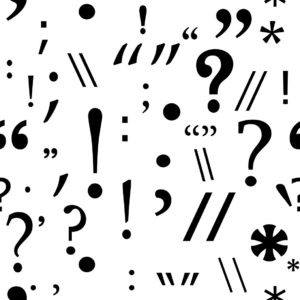by Gabrielle C. Durham
 My friend does not use punctuation when he texts, so there is a stream-of-consciousness quality to much of his communications. According to the fine folks at Buzzfeed, you would likely infer that he is a millennial, but that is not true. He conveys his points while eschewing syntactic finality fairly clearly, so when he does use punctuation, he makes a big deal of it, as in “Look. At. The. Punctuation. I’m. Using.”
My friend does not use punctuation when he texts, so there is a stream-of-consciousness quality to much of his communications. According to the fine folks at Buzzfeed, you would likely infer that he is a millennial, but that is not true. He conveys his points while eschewing syntactic finality fairly clearly, so when he does use punctuation, he makes a big deal of it, as in “Look. At. The. Punctuation. I’m. Using.”
According to this article, using ending punctuation (specifically a period) in a text can convey insincerity (by way of gratuitous formality) or anger due to code-switching. That sounds a little forced to me, but I’m a Gen Xer, so I do not fit in the classification of folks who are deemed to be responsible for killing half the industries your parents relied on utterly.
Punctuation, which comes from the Latin root punctatio for making a point from the verb pungere, which means to pierce (circa 1539), is the set of standardized symbols in every language, and the marks do vary, that clarify meaning by separating phrases, clauses, and sentences as well as by adding breathing cues. Pablo Picasso described punctuation marks as “the fig leaves that hide the private parts of literature.” The standard punctuation marks in English are period, question mark, exclamation point, comma, colon, and semicolon.
A period ends a sentence. A question mark ends a question. An exclamation point indicates strong feeling, whether positive or negative. A comma is used in the sentence, not at the end, and it indicates a pause. A colon is also used in the sentence, not at the end, to introduce an idea, a list, or a quotation. A semicolon is used to connect two clauses into one sentence.
You have, of course, seen other punctuation marks, some of which enter the realm of whimsical impracticality (do you know what a hedera looks like or is used for?). Take a look at some of the marks, along with how to reproduce them correctly here. These symbols and stylings are like porn to me, so it’s probably for the best that we do not further explore the different viewpoints on em and en dashes or curly versus straight quotes, their usage, and how to style appropriately. You’re welcome, gentle reader. This is typographical territory, so not technically pertaining to the grammatical usage of punctuation marks, but it can be interesting.
If you have ever had the opportunity to look at manuscripts from antiquity or the Middle Ages, you may have noticed that punctuation was stingily presented, at best, mostly as points. Characters tend to run together, partially in service of conserving the papyrus, paper, or other medium used, as well as ink. There was no standardized system, so depending on the scribe and later printer, punctuation was subjective and independently used of syntax. Imagine reading a sentence along the lines of “My lord’s pangolin will come when • the streams and marshes become • clear as the pool Narcissus found • captivating” What it lacks in clarity or sense, it makes up for in random punctuation that contributes absolutely nothing. The playwright and grammarian Ben Jonson produced a definitive guide for punctuation in 1640 posthumously, and the marks themselves approximately equivalent to today’s symbols are credited to two Venetian printers in the 15th and 16th centuries, grandfather and grandson, both named Aldus Manutius.
The names for most punctuation marks come from Greek, and the names refer to the sections of text, not the marks per se. “Colon” comes from kolon, which was a part of a section of a poem, and later assumed its more popular meaning of a clause in a sentence of either verse or prose. “Comma” derived from the verb koptein, to cut, or a part of verse that was cut off from the rest of the line. “Period” is taken from Greek (“way round”) to refer to the structure of a sentence, which is complete when it has a balanced number of main and dependent clauses. British English has adopted “full stop,” whereas American English uses “period” more often. The term “question mark” has only been in common parlance for the past century, replacing the late 16th-century term “mark/point of interrogation.”
Punctuation, therefore, is good for something: clarifying sentence length and structure, removing ambiguity, and giving visual cues to be able to read more fluently. I doubt that will suddenly lead my friend and legions of hurried texters to restore the fig leaves to their literary output.
